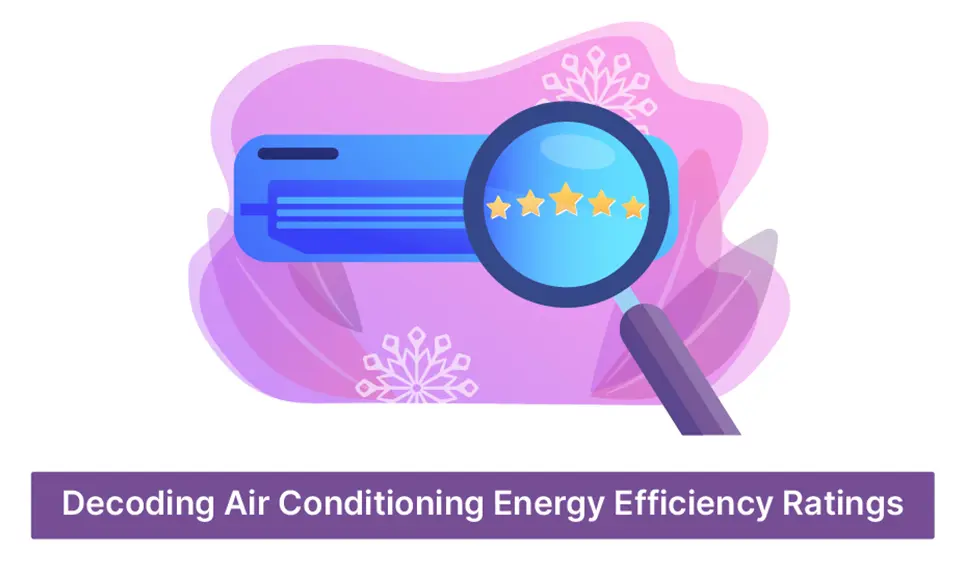Here’s a known fact – Most modern-day households and commercial spaces have an air conditioner.
And here’s an unknown fact – Air conditioning is also the biggest contributor to our energy consumption and energy costs.
In commercial spaces, around 30-50% of energy consumption is due to air conditioning. As a result, it’s hard to ignore energy efficiency whenever we talk about air conditioning.
Now, we all would have come across some labels and ratings on top of the AC or on the AC packaging. Most of you would have guessed them to be energy ratings, or in simple words, how efficient the air conditioning system is.
But have you ever wondered what those ratings are? What do those acronyms stand for? Because if you know them, you will be more capable of purchasing the best air conditioner in the market with high efficiency. Manufacturers definitely don’t make it easy for us to interpret and understand these air conditioner efficiency numbers.
So that’s where this post can help as we uncover those acronyms and interpret all those efficiency ratings to help you in your next purchase.
Seasonal energy efficiency ratio (SEER)
Most air conditioner efficiency numbers are measured in laboratory conditions. However, the SEER is calculated based on the seasonal average energy efficiency of the cooling equipment. The Seasonal Energy Efficiency Ratio is calculated as
SEER = Cooling output in BTU (British Thermal Unit) / Electrical usage in kWh.
This number will give you a perfect assessment of your air conditioning unit’s efficiency over a year. The higher the SEER value, the more efficient the unit is. Choosing an AC unit with a SEER rating of 13 instead of 10 would reduce your power consumption by 30%.Here are some recommended SEER values –
- Based on the unit type and its location, your SEER value can range anywhere between 13 – 30+.
- In the northern states of the US, the air conditioning units must have a minimum SEER value of 13.
- The southern states mandate a minimum rating of 14.
- A central air conditioning system’s SEER rating should be between 20 to 28.
- Mini-splits without ducts and heat pumps should have a SEER rating of 30 or more.
Energy efficiency ratio (EER)
This energy efficiency ratio is calculated under specific test conditions like peak load during hot temperatures. EER is also the measurement of the cooling output of an air conditioner. It is calculated as
EER = Capacity in British Thermal Unit per hour (BTU/h) / Power (in Watts)
The higher the EER value, the more energy-efficient the air conditioning system is. The optimal EER value can be from 8 to 19. For instance, an AC unit with an EER rating of 11 is 29% more energy efficient than the one with an EER of 8.5. In regular households or commercial spaces where the temperatures won’t go very high, you can use AC with an EER rating ranging between 8.5 to 16.2.
Heating seasonal performance factors (HSPF)
Some of you would have heard about heat pumps. These units produce both cooling and heating. An HSPF measures the efficiency of such units. To be more precise, the cooling efficiency of these systems is measured using SEER and EER, while the heating efficiency is measured using HSPF.
HSPF = Total heating space in BTU / Total electricity used by pumps in kilowatt hr.
The higher the HSPF ratio, the more efficient the system is. It is best to choose heat pumps with an HSPF rating between 8 to 13.
Energy guide
Today, almost all air conditioning systems come with energy guide labels. These labels indicate how much energy the unit uses and how much it saves in a year. In such labels, look out for the following labels.
Estimated yearly energy cost
This is the amount you will save on utilities every year. This is calculated by comparing the AC unit’s performance capacity with the national average electricity cost.
Appropriate ratio
This will give an estimate of how well the system would perform in your household. In other words, it tells whether you own an energy-efficient air conditioning system or not. If you are purchasing a central AC system, look out for SEER ratings; if the purchase is for home, then look out for EER ratings.
Energy star
We all would have seen the energy star labels on an AC unit or its package. It indicates that the specific AC unit has passed all the energy efficiency standards set by the US Department of Energy. Units with this label are the most cost-effective systems in the market.
Conclusion
The world is using up more and more energy, leading to global warming. Air conditioning alone contributes to more than 6% of all electricity generated in the US. Understanding energy efficiency and energy-saving have become extremely important today. Knowing the labels and numbers associated with efficiency will help you choose energy-efficient air conditioners. This way, you can do your part in reducing global warming and its impact on flora and fauna.
You can read more blogs on HVAC here.









